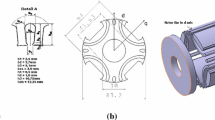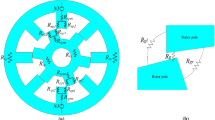Abstract
Finite element method is a powerful tool in analysis of electrical machines; however, the computational cost is high depending on the geometry of analyzed machine. In synchronous reluctance machines with transversally laminated rotors, the anisotropy of magnetic circuit is provided by flux barriers which can be of various shapes. Flux barriers of shape based on Zhukovski’s curves seem to provide very good electromagnetic properties of the machine. Complicated geometry requires a fine mesh which increases computational cost when performing finite element analysis. By using magnetic equivalent circuit, it is possible to obtain good accuracy at low cost. This paper presents magnetic equivalent circuit of synchronous reluctance machine with new type of flux barriers. Numerical calculation of flux barriers’ reluctances will be also presented.




















Similar content being viewed by others
References
Tahi S, Ibtiouen R, Bounekhla M (2011) Design optimization of two synchronous reluctance machine structures with maximized torque and power factor. Prog Electromagn Res 35:369–387
Schmidt E, Brandl W, Grabner C (2004) Optimization of a synchronous reluctance machine for a sensorless drive with a wide field-weakening range. e&i. Elektrotechnik und Informationstechnik 121:89–94
Hanamoto T, Ghaderi A, Fukuzawa T, Tsuji T (2006) Sensorless control of synchronous reluctance motor using modified flux linkage observer with an estimation error correct function. In: Recent developments of electrical drives: best papers from the international conference on electrical machines ICEM’04, Springer, Netherlands, pp 155–164
Litvinov BV, Davydenko OB (2010) Synchronous reluctance motors with lowered magnetic conductivity along transverse axis. Russian Electr Eng 81(3):121–125. \(\copyright \) Allerton Press, Inc., ISSN: 1068-3712
de Jong HCJ (1993) The variable-speed reluctance machine with cageless barrier rotor. Arch Elektrotech 76(6):451–455
Lipo TA (1991) Synchronous reluctance machines—a viable alternative for AC drives. Wisconsin Electric Machines and Power Electronics Consortium, Research Report, May, 1991
Miller TJE, Hutton A, Cossar C, Staton DA (1991) Design of a synchronous reluctance motor drive. IEEE Trans Ind Appl 27(4):741–749
Kolehmainen J (2010) Synchronous reluctance motor with form blocked rotor. IEEE Trans Energy Convers 25(2):450–456
Russenschuck S, Andresen EC (1991) The influence of rotor design and inverter type on the magnet volume of synchronous machines investigated by numerical field calculation and vector-optimization methods. Arch Elektrotech 75(1):61–69
Bomela XB, Kamper MJ (2002) Effect of stator chording and rotor skewing on performance of reluctance synchronous machine. IEEE Trans Ind Appl 38(1):91–100
Tariq AR, Nino-Baron CE, Strangas EG (2010) Iron and magnet losses and torque calculation of interior permanent magnet synchronous machines using magnetic equivalent circuit. IEEE Trans Magn 46(12):4073–4080
Shin K-H, Ju-Seong Y, Choi J-Y, Cho H-W (2014) Design and analysis of interior permanent magnet synchronous motor considering saturated rotor bridge using equivalent magnetic circuit. J Magn 19(4):404–410
Komęza K, Pelikant A (1990) Calculation of electromagnetic field of a double reluctance motor using the finite element and reluctance network methods. Arch Elektrotech 73:3–8
Stig E (1964) Generalized reluctances in eddy current magnetic circuits. Arch Elektrotech 49:67–72
Deihimi A, Farhangi S, Henneberger G (2002) A general nonlinear model of switched reluctance motor with mutual coupling and multiphase excitation. Electr Eng 84:143. doi:10.1007/s00202-001-0113-3
Perho J (2002) Reluctance network for analysing induction machines. Acta Polytechnica Scandinavica, Electrical Engineering Series, No. 110, Espoo
Kostko JK (1923) Polyphase reaction synchronous motors. J Am Inst Electr Eng 42:1162–1168
Moghaddam RR (2011) Synchronous reluctance machine (SynRM) in variable speed drives (VSD) applications. Doctoral Thesis, Stockholm, Sweden
Marlewski A (2005) Graphing Zhukovski transformation in Derive. In: Proceedings 19th European conference on modelling and simulation Yuri Merkuryev, Richard Zobel, Eugène Kerckhoffs \(\copyright \)ECMS
Oprea C, Dziechciarz A, Martis C (2015) Comparative analysis of different synchronous reluctance motor topologies. In: 15th IEEE international conference on environment and electrical engineering, 10–13 June 2015, Rome, pp 1904–1909, Print ISBN: 978-1-4799-7992-9
Hubert T, Steckel R, Reinlein M, Kremser A, Herzog H-G (2015) Nonlinear reluctance network method for synchronous reluctance machine analysis. In: 18th international conference on electrical machines and systems (ICEMS)
Dziechciarz A, Martis C (2016) Magnetic equivalent circuit of synchronous reluctance machine. In: 11th international conference ELEKTRO 2016, Slovakia
Williams JM (2004) Modeling and analysis of electric machines with asymmetric rotor poles using a reluctance based, magnetic equivalent circuit. Doctoral thesis, University of Missouri-Rolla
Ostović V (2012) Dynamics of saturated electric machines. Springer, New York. ISBN-13: 978-1-4613-8935-4
Li B, Liu C, Li H, Li G (2011) Torque analysis of spherical permanent magnetic motor with magnetic equivalent circuit and Maxwell stress tensor. In: Informatics in control, automation and robotics, vol 2. Springer, Berlin, pp 617–628, ISBN: 978-3-642-25992-0
Paap GC, Vos EJA (1990) On the steady-state determination of networks containing magnetic nonlinearities. Arch Elektrotech 73:109–114
Rettinger F, Huth G (2016) Variable-speed PM synchronous motors with ferrite excitation. Electr Eng. doi:10.1007/s00202-016-0393-2
Pellegrino G, Jahns TM, Bianchi N, Soong WL, Cupertino F (2016) The rediscovery of synchronous reluctance and ferrite permanent magnet motors—tutorial course notes. SpringerBriefs in electrical and computer engineering, ISBN: 978-3-319-32202-5
Acknowledgements
This paper is part of the ADvanced Electric Powertrain Technology (ADEPT) project which is an EU funded Marie Curie ITN project, Grant Number 607361.
Author information
Authors and Affiliations
Corresponding author
Rights and permissions
About this article
Cite this article
Dziechciarz, A., Martis, C. Simplified model of synchronous reluctance machine with optimized flux barriers. Electr Eng 99, 1207–1216 (2017). https://doi.org/10.1007/s00202-017-0616-1
Received:
Accepted:
Published:
Issue Date:
DOI: https://doi.org/10.1007/s00202-017-0616-1




